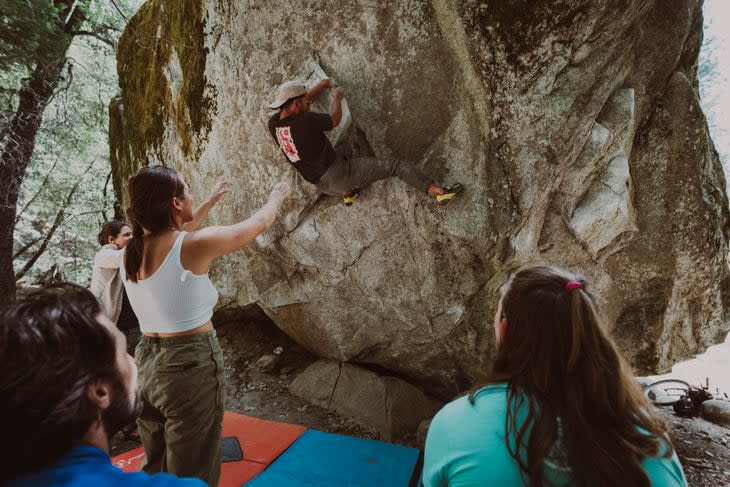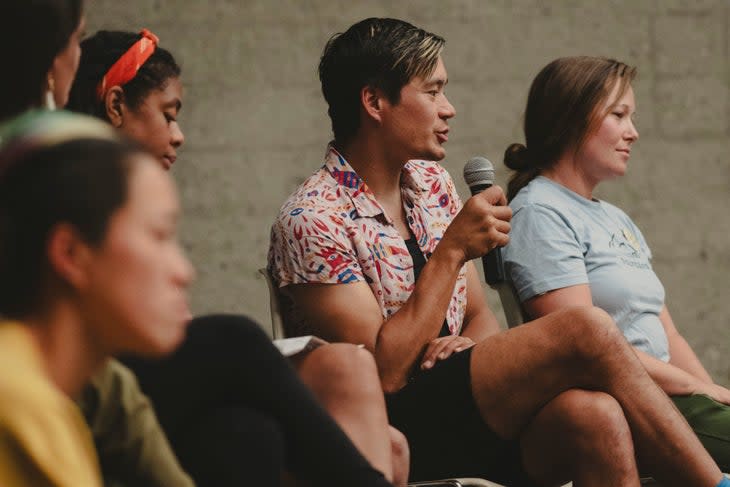United in Yosemite Wasn’t a “Trendy” Diversity Initiative
This article originally appeared on Climbing
Heat waves rose from the valley floor on June 23 at the Yellow Pines campground in Yosemite. There was an excited bustle as climbers donned gear and gathered around instructors, kick-starting the United in Yosemite festival--a historic moment in the evolution of interactions between public lands agencies and the climbing community. The 120-year-old American Alpine Club and the 106-year-old Yosemite Parks Service, supported by the Yosemite Conservancy, had come together with local groups to host the five-day event.
Yosemite has always been dominated by larger-than-life figures. We tend to think of legends from Royal Robbins and Yvon Chouinard to Lynn Hill or John Long to today's top climbers, including Alex Honnold and Tommy Caldwell. We think of the wilderness itself, romanticized by campfire stories, books, and paintings. And we think of the walls as being the ultimate proving grounds for our community--everyone who hasn't been to Yosemite wants to go, and those who have want to return. Like any good crag, Yosemite offers a sense of freedom from everyday life, but, thanks to its sheer size and historic relevance, it is uniquely idyllic.
"America's National Parks have always represented one of the great democratic ideals," says Jesse Charkrin (he/him), a Yosemite Park Ranger of almost two decades. Charkrin has worked in the education, outreach and community engagement side of rangering since 2006. He added that the Parks Service has endeavored to "protect these beautiful spaces for all people." But Yosemite has a well-documented history of being complicit in the displacement of Tribes, segregation, and discrimination.
Plans for United in Yosemite began in late 2021. The event's leadership is a collective of climbers and outdoor enthusiasts who work to increase accessibility to outdoor spaces and public lands. The organizers included Rock Guide Thomas Bukowski (he/they), self-described queer botanist and half-decent rock climber Emily Fong (she/they), AAC Climb United Manager Shara Zaia (she/her), Brown Girls Climb Executive Director Brittany Leavvit (she/her), and Jesse Charkrin. They had a multi-faceted goal: to create space for mentorships amongst climbers from historically marginalized groups, and to commit to best-practices that often get lost when scaling grassroots events to a national scale. The event included clinics for all levels and guest speakers.

Oftentimes, affinity group leaders and facilitators put up much of their personal time and money to run their organizations. Working to improve diversity and access is trendy. Every brand wants a friendly face to represent them. Usually, guides, photographers, models, community organizers, ambassadors, and climbers who belong to a marginalized community are offered exposure as payment. This issue can become more prevalent the bigger the event, the bigger the brand logo.
United in Yosemite is different: affinity groups like Brown Girls Climbs, Queer Crush, and ParaCliffhangers worked closely with the AAC and the Yosemite Parks Service. From the start, the event was intended to be community-run. "Every organization and brand involved in this event are committed to best-practices," said Charkrin, "all of our clinic and workshop advisors were paid for their time. We strove to make sure that everyone who contributed to the festival felt fairly compensated for their time." The AAC and Parks Service were determined to use their privilege to create space, but step aside once it has been created. It was up to the leaders of United in Yosemite to run the show.
"Historically, climbing festivals with the AAC and beyond were not created with these communities in mind," says Zara, Climb United Manager, who also runs an affinity group Cruxing in Color. DEI initiatives have been an afterthought. "While festivals like Color the Crag and Homoclimbtastic have been doing this work for years, it's never too late for an organization to start. It's within spaces like United in Yosemite where we see folks not only facing the mental and physical challenges of climbing, but overcoming the social and cultural barriers as well."

The event leaders were no strangers to climbing festivals. They did the research. "We wanted to make sure we were not only providing space, but learning what we could do as far as supporting all the people who might want to be involved in the event," says Charkrin.
The festival is entirely free of charge to participants. A lottery system was used to distribute the 100 available spaces (15% of the tickets were reserved for members of the seven traditionally associated Tribes of Yosemite, and 10% of tickets were reserved for people with disabilities). Travel stipends were also available via application. United in Yosemite received over 300 applicants.
It seems the goal has been achieved. Among the flood of participant social media posts praising the festival, Tuere Lawton (she/her) wrote on her profile, "I've fallen in love, reflected on heartbreak, felt seen for the first time since I've moved back to the US, and watched my life change for the better." AMGA Rock Guide Genevive Walker, who taught a trad-climbing clinic at the festival, said, "So many of us feel like the outsider or the 'other' in outdoor spaces like climbing and UiY helped us see that we're not alone."
The climbing community is proud of our counter-culture roots, but climbing has evolved. From our humble hemp-rope era into showstopping competitions, gym climbing, eye-raising monthly gym membership fees, and almost dysfunctionally large climbing holds, we still relish the steely determination and courage that motivates us to venture into both the human unknowns and the personal ones. The community at large believes mountains, rocks, and forests can't be racist, homophobic, ableist, or transphobic. And they are right. However, every community is a reflection of the world it exists in. Even a sport with roots as niche as climbing is no exception.
In a perfect world that celebrates all our human differences, would affinity groups still be necessary? Brittany Leavitt, a founding member of Brown Girls Climb, believes affinity spaces are often misunderstood. Climbers exist in a microcosm within a country of exceptionally unusual political divisiveness. It is easy to believe that affinity groups are all about race and identity. "We must also consider experiences. Affinity groups have existed without race as a perspective for a while. Veterans, working mom support groups, educators, sports teams; these groups are focused on experiences first and foremost. Race and identity may not come into play at all. Even in a perfect world, we need that space to connect."
Many organizations like Brown Girls Climb have been around since before "diversity" became a buzzword. The people behind United in Yosemite didn't do the work because it's trendy, they did it as a first step. The festival was not created to solve all the problems of equity and inclusion in the outdoor industry; that is not the work of one, two, or even ten organizations alone. But the literary resonance of the event happening in such a historic National Park exemplifies the new era of the outdoor industry taking tangible steps to listen to the leaders who are changing our community from a grassroots level.
Also Read
For exclusive access to all of our fitness, gear, adventure, and travel stories, plus discounts on trips, events, and gear, sign up for Outside+ today.

